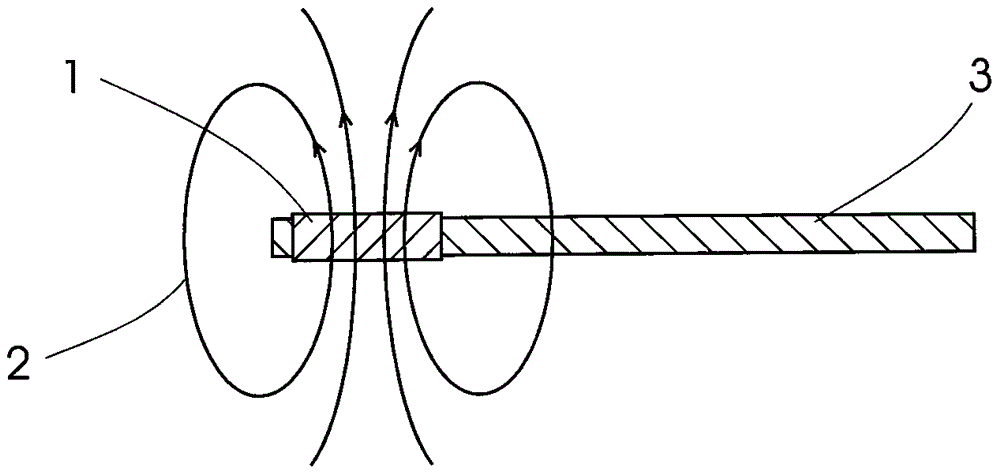Ion generator
An ion generator and generator technology, applied in separation methods, dispersed particle separation, chemical instruments and methods, etc., can solve problems such as ozone generation and application limitations, and achieve the effects of easy material acquisition, strong chemical reaction, and simple structure
- Summary
- Abstract
- Description
- Claims
- Application Information
AI Technical Summary
Problems solved by technology
Method used
Image
Examples
Embodiment 1
[0019] Such as figure 1 As shown, the basic structure of the ion generator of the present invention has two parts, namely a magnetic field generator 1 and a titanium dioxide device 3 . The magnetic field 2 generated by the magnetic field generator 1 (represented by a curve with an arrow in the figure, only part of the magnetic field is drawn, and the arrow indicates the direction of the magnetic field) intersects the titanium dioxide device 3 . The magnetic field 2 has suitable strength and direction, enough to make the ions around the titanium dioxide device 3 leave the titanium dioxide device 3 quickly, and the magnetic field generator 1 can be an electromagnet made of electronic components or a permanent magnetic material made permanent magnets. The electromagnet has the advantages of controllability and flexible manufacture, and the use of permanent magnets can make the structure of the ion generator simple and compact without consuming electricity. The titanium dioxide ...
Embodiment 2
[0021] Such as figure 2 , image 3 Shown is a structural schematic view of the ion generator of the present invention applied to purify air. For the convenience of description, it is represented by a cross-sectional view. The magnetic field generator 1 selects regular-shaped permanent magnets, which can be square, circular, polygonal, etc., to facilitate installation. Common permanent magnet materials include alloy permanent magnet materials and ferrite permanent magnet materials. The commonly used permanent magnets are NdFeB, rubber magnets, etc. The titanium dioxide device 3 is made of a nickel foam mesh covered with nano-titanium dioxide on the surface, that is, a nickel foam mesh with nano-titanium dioxide. Described permanent magnet is attached on described nano-titanium dioxide foamed nickel mesh, as figure 2 As shown, or, the permanent magnet is pressed and embedded on the nano-titanium dioxide foamed nickel mesh, such as image 3 As shown, in order to make the m...
Embodiment 3
[0023] Such as Figure 4 , Figure 5 Shown is a structural schematic view of the ion generator of the present invention applied to purify air. The magnetic field generator 1 adopts a permanent magnet, and the permanent magnet can be a strong magnetic neodymium-iron-boron, rubber magnet, etc., and the titanium dioxide device 3 is a nano-titanium dioxide foamed nickel mesh with a double-layer structure, leaving a gap between the layers, and the double-layer structure Consists of two nanometer titanium dioxide foamed nickel nets (such as Figure 4 shown) or bent from a piece of nano-titanium dioxide foam nickel mesh (such as Figure 5 shown), the permanent magnet is pressed and embedded on the nano-titanium dioxide foamed nickel mesh (such as Figure 4 shown) or sandwiched between the nano titanium dioxide foam nickel mesh (such as Figure 5 As shown), the magnetic field 2 generated by it intersects with the titanium dioxide device 3 . Figure 5The case where there is more t...
PUM
 Login to View More
Login to View More Abstract
Description
Claims
Application Information
 Login to View More
Login to View More - R&D
- Intellectual Property
- Life Sciences
- Materials
- Tech Scout
- Unparalleled Data Quality
- Higher Quality Content
- 60% Fewer Hallucinations
Browse by: Latest US Patents, China's latest patents, Technical Efficacy Thesaurus, Application Domain, Technology Topic, Popular Technical Reports.
© 2025 PatSnap. All rights reserved.Legal|Privacy policy|Modern Slavery Act Transparency Statement|Sitemap|About US| Contact US: help@patsnap.com



